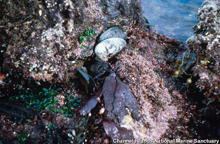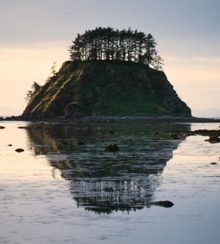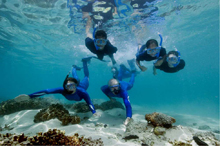Movies, Podcasts and Simulations: New Tools for a New Age
The NOAA National Marine Sanctuary Program manages and protects 13 sanctuaries and one marine national monument encompassing over 150,000 square miles of U.S. ocean. Important habitats like coral reefs, kelp forests, historic shipwrecks and the breeding and feeding grounds of whales, sea lions, sharks and sea turtles are represented within the system of sanctuaries.
- Introduction
- A Mature Sanctuary System
- 21st Century Information Age
- Capturing the Public's Imagination
- Real Life Experiences
- Podcasts - Mass Communication
- Conclusion
- Works Consulted
Vast expanses of pristine waters. Breeding and feeding grounds of whales, sea lions, sharks, and sea turtles. Historic shipwrecks. Vivid coral reefs. These are just some of the marine treasures that NOAA works to manage and conserve through its National Marine Sanctuary Program.
The primary objective of the NOAA National Marine Sanctuary Program is resource protection. The National Marine Sanctuaries Act provided NOAA with a broad conservation mandate and specific legal authorities to protect nationally significant areas of U.S. oceans and the Great Lakes. The sanctuary program remains the only program that has specific authority for coordinated conservation and management of these marine areas.

Tidepools in the Channel Islands National Marine Sanctuary are homes to diverse life forms. Sea anemones, shell fish, small fish, octopi, crabs, and algae are common residents. The distribution of organisms is dependant on water level, temperature, and competition between species. Click image for larger view and image credit.
In meeting this mandate, NOAA must engage the public, so that those who use, enjoy, and benefit from sanctuaries understand the importance of protecting these special marine areas. However, vying for the public's attention amid an ever-rising tide of multimedia input is not an easy task.
Each and every day we are bombarded with information, from the Internet, television, blogs, satellite radio - it is easy to go into information overload. It is in this sea of stories that the sanctuary program envisions its future. Through innovative approaches to media and communications, NOAA will work to efficiently reach the American public with effective messages about the importance of the mission of the marine sanctuaries.
Envisioning a Mature Sanctuary System
The sanctuary program aspires to be a world-class system of sanctuaries that protects the nation's natural and cultural marine resources for future generations.

The broad rocky intertidal zones and offshore islands of the Olympic Coast National Marine Sanctuary create complex wildlife habitat-rich feeding zones for fish, and invertebrates as well as nest and perch habitats for watchful bald eagles and peregrine falcons. Click image for larger view.
"A goal for the future will be to achieve what the sanctuary program defines as a 'mature system,'" said Dan Basta, director of the National Marine Sanctuary Program. "This will include adequate protection of sanctuary resources, system-based management, international reach, integrated conservation science and education, and community involvement, among other things."
In this future sanctuary system, Mr. Basta said, "every marine sanctuary must establish the significance of the resources it protects, demonstrate an ecological contribution and an ability to preserve culturally or historically significant resources, and demonstrate that the financial cost of the site does not outweigh its contributions to the public."
"There will be sanctuaries in all of the major ecosystems of the nation's oceans and Great Lakes, and the sanctuary program will be formally cooperating in ecosystem-based management and scientific research efforts with other regional, national, and international marine protected area networks. Additionally, every sanctuary in a mature system will have a clear understanding of the ecological, social, economic, and cultural systems operating in the sanctuary and the ecosystem in which it is located."
The 21st Century Information Age - Challenges and Opportunities
The Information Age poses both the greatest challenge and the greatest opportunity in determining how effective the sanctuary program is at meeting its mandate.

In the ever-expanding world of electronic media, the National Marine Sanctuary Program must find ways to get its message out and heighten public awareness of the importance of sanctuaries. One mechanism the program uses is broadcasting research missions live online. Click image for larger view.
"The world is becoming more complicated. Mass media and the Internet have dramatically increased the amount of information to which the average American is exposed on a daily basis, and it has proved challenging for the sanctuary program to maintain its visibility," Mr. Basta said.
All organizations that protect the environment must compete with the multitude of sources of entertainment available today if they are to capture the public's attention. These organizations must convince people that environmental issues are important and relevant to everyone. Rather than shy away from this competition, however, the sanctuary program is learning lessons from the media and entertainment industries and incorporating those lessons into creative new outreach strategies and programs.
Capturing the Public's Imagination Through Film
Film is one medium in which the sanctuary program has already made considerable strides, finding that movies are powerful and effective tools. Beyond the limitations of a news broadcast or print media, a film has the ability to delve deeper into a subject, using a variety of sights, sounds, dialogue, and music to produce emotions that leave a lasting impact. It is this lasting effect that is most important to the sanctuary program, because it can leave people feeling passionate about ocean conservation long after the movie has ended.

Jean-Michel Cousteau and the Underwater Treasures Team explore Fagatele Bay in American Samoa. Click image for larger view and image credit.
One example of the potential impact of film was illustrated last year, when conservationist and filmmaker Jean-Michel Cousteau, son of Jacques-Yves Cousteau, released a new documentary series Ocean Adventures in 2006 that visited each site in the National Marine Sanctuary System in a two-part PBS special. The first part of the series, Voyage to Kure, was so powerful that it is partially credited for Present George W. Bush's decision to create the Northwestern Hawaiian Islands Marine National Monument; the largest marine protected area in the world, covering more than 130,000 square miles.
Moving into the future, the sanctuary program will continue to work with partners to explore how the world of film can increase public understanding of the value of our marine sanctuaries.
Bringing Real Life Experiences to a Shopping Mall Near You

The Florida Keys National Marine Sanctuary staff conducts presentations for local schools and groups, helping to instill an interest and appreciation of our oceans in younger people. Build an Ocean, shown here, is a presentation designed for grade school students. Build an Ocean teaches students about the animals that live in the ecosystems and how they interact with their surroundings. Click image for larger view and image credit.
During the last two years, the National Marine Sanctuary Program has partnered with a video game company to produce an educational submarine voyage simulation ride. The ride is interactive and the course of the "voyage" is determined by the users' decisions. Inside the submarine-shaped simulator, the video screen recreates an underwater environment using realistic computer animation. The sanctuary program provided the creators and artists with information, pictures, and critiques in order to make this game as accurate and educationally useful as possible.
The simulator is another good example of how the sanctuary program is using new technology to grab people's attention and get them interested in the marine sanctuaries through a non-traditional outreach tool. Interactive games such as this appeal to children, who have fun and learn about the oceans at the same time, hopefully instilling them with a lifelong interest in protecting our natural environment.
Podcasts - The Next Trend in Mass Communication
The sanctuary program has already started using podcasts, a media technology that is rapidly growing in popularity, as a way to broadcast its messages.

The garibaldi is lucky enough to be protected not only within the boundaries of our marine sanctuaries, but by California state law as well. They are intensely curious about divers and are known for being very aggressive when defending their territory or eggs. During the spring, these feisty fish will vigorously defend their nests from unwelcome guests - no matter how large. Click image for larger view and image credit.
Podcasting is a method of distributing multimedia files over the Internet. A user subscribes to a podcast - similar to a radio show - and new episodes are automatically downloaded to the user's computer or personal media player as they are released. The sanctuary program has begun to use this technology as a way to widely distribute a radio show hosted by Cordell Bank National Marine Sanctuary staff.
With this technology, information can be produced on sanctuary news, expeditions, and even scuba dives with captivating video footage and educated commentary. This low-cost, yet dynamic, way to reach targeted audiences will revolutionize how we communicate to a wired American populace.
Conclusion
The sanctuary program must maximize its visibility if it is to be effective in reaching the public about the importance of protecting our nation's ocean and Great Lakes treasures. Reaching the public is becoming increasingly challenging as competition for their attention intensifies. However, the sanctuary program is committed to implementing new and innovative communications strategies to address this challenge. As technology advances, the program will continue to find new applications, whether it is through television, print media, the Internet, or alternative outreach programs. These efforts will ensure that the American public understands the importance of their marine sanctuaries - an important link in the long-term conservation of these areas.
Works Consulted
U.S. Department of Commerce. (2006). National Marine Sanctuary Program: State of the Sanctuary Report 2005-2006. Retrieved November 3, 2006, from: http://sanctuaries.noaa.gov/sos05/sosreport2005.pdf
